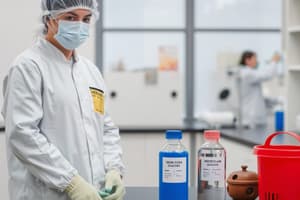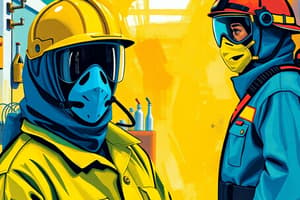Podcast
Questions and Answers
What is the primary purpose of Personal Protective Equipment (PPE) in the laboratory?
What is the primary purpose of Personal Protective Equipment (PPE) in the laboratory?
- To standardize clothing among personnel
- To minimize exposure to chemical and biological hazards (correct)
- To enhance comfort while working
- To provide a barrier against physical injuries
Which of the following is NOT a requirement for laboratory coats?
Which of the following is NOT a requirement for laboratory coats?
- Coats should preferably have fitted cuffs
- Coats can be stuffed into personal lockers (correct)
- Coats should be worn closed at all times
- Coats must be of sufficient length to cover the knees
What method is considered the most efficient for sterilizing laboratory materials?
What method is considered the most efficient for sterilizing laboratory materials?
- Incineration
- Autoclaving (correct)
- Chemical treatment
- Filtration
In relation to laboratory coats, which practice should be strictly avoided?
In relation to laboratory coats, which practice should be strictly avoided?
Which method is primarily used for the disposal of biological agents and animal carcasses?
Which method is primarily used for the disposal of biological agents and animal carcasses?
What should be done with visibly contaminated laboratory coats?
What should be done with visibly contaminated laboratory coats?
Why is it important that laboratory coats are worn only in designated areas?
Why is it important that laboratory coats are worn only in designated areas?
What is a critical maintenance practice for reusable laboratory coats?
What is a critical maintenance practice for reusable laboratory coats?
Which of the following is a recommended feature of laboratory coats?
Which of the following is a recommended feature of laboratory coats?
What materials are commonly used to make pipette aspirators?
What materials are commonly used to make pipette aspirators?
What is the primary mechanism by which pipette aspirators create suction?
What is the primary mechanism by which pipette aspirators create suction?
Which closure mechanism is NOT commonly found in polyethylene bags?
Which closure mechanism is NOT commonly found in polyethylene bags?
What is the advantage of using thicker polyethylene bags?
What is the advantage of using thicker polyethylene bags?
What kind of closure allows repeated opening and closing in polyethylene bags?
What kind of closure allows repeated opening and closing in polyethylene bags?
What type of device best describes pipette aspirators?
What type of device best describes pipette aspirators?
Which of the following is an application for polyethylene bags?
Which of the following is an application for polyethylene bags?
What characteristic distinguishes the manufacturing of polyethylene bags?
What characteristic distinguishes the manufacturing of polyethylene bags?
What action is performed to generate a vacuum in a pipette aspirator?
What action is performed to generate a vacuum in a pipette aspirator?
What role does respiratory protection play in a risk assessment?
What role does respiratory protection play in a risk assessment?
Which of the following is essential when handling laboratory reagents?
Which of the following is essential when handling laboratory reagents?
What specific feature distinguishes an analytical balance?
What specific feature distinguishes an analytical balance?
What type of gas source is commonly used in a Bunsen burner?
What type of gas source is commonly used in a Bunsen burner?
What should be done immediately after contact with toxic reagents occurs?
What should be done immediately after contact with toxic reagents occurs?
Why might respiratory protection be required beyond biological hazards?
Why might respiratory protection be required beyond biological hazards?
How accurate can an analytical balance measure mass?
How accurate can an analytical balance measure mass?
Which is NOT a function of a Bunsen burner?
Which is NOT a function of a Bunsen burner?
In laboratory biosafety, why is correct labeling of containers necessary?
In laboratory biosafety, why is correct labeling of containers necessary?
What is the primary function of Parafilm in laboratory settings?
What is the primary function of Parafilm in laboratory settings?
Which characteristic of Parafilm makes it advantageous for visual inspection of samples?
Which characteristic of Parafilm makes it advantageous for visual inspection of samples?
What is a notable feature of handling and applying Parafilm?
What is a notable feature of handling and applying Parafilm?
In which application is Parafilm NOT typically used?
In which application is Parafilm NOT typically used?
What type of laboratory tool is a Pasteur pipette?
What type of laboratory tool is a Pasteur pipette?
For what volume range are Pasteur pipettes typically available?
For what volume range are Pasteur pipettes typically available?
Who is the Pasteur pipette named after?
Who is the Pasteur pipette named after?
Which of the following statements about reusing Parafilm is true?
Which of the following statements about reusing Parafilm is true?
What is a common usage of Pasteur pipettes in laboratory settings?
What is a common usage of Pasteur pipettes in laboratory settings?
What is the primary purpose of RNase treatment for pipette tips?
What is the primary purpose of RNase treatment for pipette tips?
Which of the following applications does NOT require RNase-treated pipette tips?
Which of the following applications does NOT require RNase-treated pipette tips?
What characteristic of stirring glass rods helps prevent scratching glassware?
What characteristic of stirring glass rods helps prevent scratching glassware?
In which situation should sterile pipette tips always be used?
In which situation should sterile pipette tips always be used?
Which type of glass is commonly used for stirring rods due to its chemical resistance?
Which type of glass is commonly used for stirring rods due to its chemical resistance?
What is the recommended practice after using RNase-treated pipette tips?
What is the recommended practice after using RNase-treated pipette tips?
Which of the following is NOT a typical use for stirring glass rods?
Which of the following is NOT a typical use for stirring glass rods?
Why are sterile or RNase-treated pipette tips classified as single-use?
Why are sterile or RNase-treated pipette tips classified as single-use?
What is a common property of borosilicate glass that makes it suitable for laboratory use?
What is a common property of borosilicate glass that makes it suitable for laboratory use?
Flashcards are hidden until you start studying
Study Notes
Personal Protective Equipment (PPE)
- PPE minimizes exposure to chemical and biological hazards in laboratory settings.
- Safety data sheets provide guidelines on necessary PPE based on material risks.
- Laboratory coats are essential to protect personal clothing from contamination.
- Coats should have long sleeves, be worn closed, and extend to knee length.
- Coats must be either reusable (laundered by laboratories) or disposable and should not be taken home.
- Regular laundering is required; visibly contaminated coats need autoclaving before washing.
- Respiratory protection may be necessary based on a risk assessment for biological or non-biological hazards.
Hazard Recognition
- All containers must be accurately labeled to prevent accidental exposure.
- Direct contact with reagents is harmful, requiring careful handling and disposal.
- In case of contact with hazardous substances, immediate flushing with water and reporting to a supervisor is necessary.
Autoclaving and Incineration
- Autoclaving effectively sterilizes materials by eliminating biological agents.
- Incineration is a common method for inactivating and disposing of hazardous and biological waste.
Laboratory Equipment
-
Analytical Balance: Highly precise weighing instrument measuring substances up to five decimal places (0.0001 - 0.00001 grams).
-
Used in chemistry, pharmaceuticals, and biology for exact measurements.
-
Bunsen Burner: Standard heating device used for sterilization and combustion, adjustable for air intake.
-
Useful for sealing containers with volatile chemicals to prevent evaporation.
-
Parafilm: Flexible film for sealing containers, transparent for easy visibility of contents.
-
Can be reused multiple times if handled correctly; applications include sealing test tubes and protecting glassware.
-
Pasteur Pipette: Tool for transferring small liquid volumes; available in various sizes (1 mL to 10 mL).
-
Commonly used in research and clinical laboratories for sample handling.
-
Pipette Aspirators: Ergonomically designed devices for creating suction, eliminating the need for external power sources.
-
Made from chemical-resistant materials, suitable for various liquid applications.
-
Polyethylene Bag: Versatile packaging container with closure options like zip-lock, heat seals, or drawstrings.
-
Thickness varies, with thicker bags suited for heavier items and thinner bags being economical.
-
RNase Treatment: Essential for maintaining RNA integrity during pipetting, ensuring compatibility with various applications.
-
Sterile tips are disposable to prevent contamination.
-
Stirring Glass Rod: Tool for mixing liquids, designed with a smooth finish for easy cleaning and efficient stirring.
-
Borosilicate glass is resistant to a variety of chemicals, making it safe for various laboratory uses.
Studying That Suits You
Use AI to generate personalized quizzes and flashcards to suit your learning preferences.




